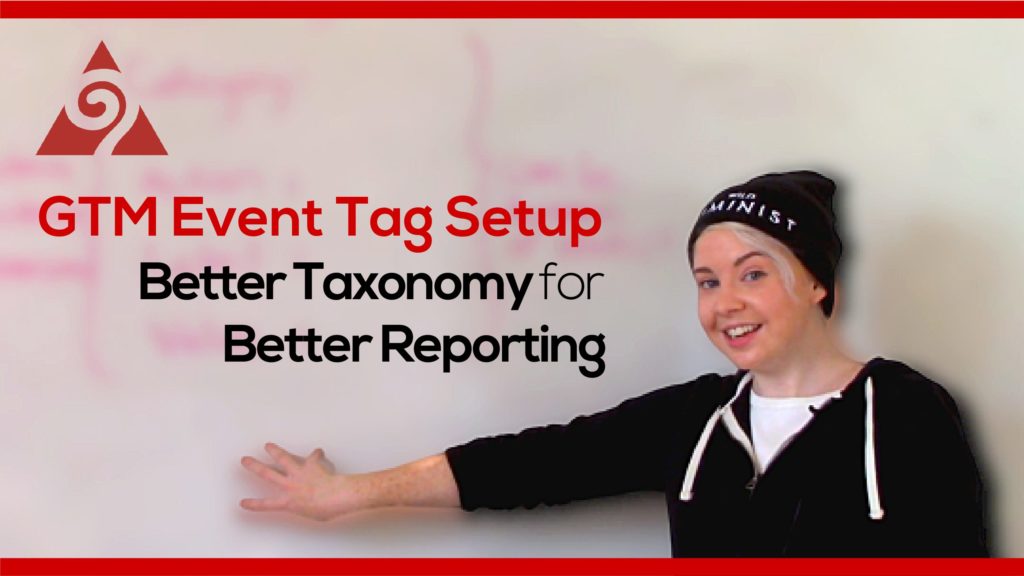Is your Google Analytics event report confusing? Augurian Analytics Manager, Megan Upperman, shows us how to create better Google Tag Manager event tags.
This way, Google Analytics goals and reporting dimensions will break down your data in a way that helps you make better business decisions.
Full Video Transcription
Hi, my name is Megan. I’m the manager of Analytics here at Augurian. I’m going to teach you about how to create a more meaningful taxonomy for your event tags for better reporting. [music] Today, I’m not going to talk about triggers, I’m just going to talk about events. Event tags are the most important thing that you can do to get these really, really right because they’re not just your tag criteria, they’re also your goal criteria in Google Analytics, and they’re your reporting dimensions. Creating a meaningful taxonomy with how you want to sort these items, and how you’d like to report on them, is the best future-proofing step that you can take. The first thing that you want to do is go through and make a list of all the events on your site that you’d like to know about. Once you get there, let’s use an example of an e-commerce site. Once you’ve got that list in hand, then basically, you just have to start by creating meaningful categories that all of those fit into. Essentially, let’s throw out a list of adding things to your cart from a product detail page, say you want to know about adding things from the special page that lists everything that’s on sale right now. When you talk about checking out, someone will have to log in before they check out. You probably want to know the difference between people who log in to an existing account, and people who log into a brand new account. When it comes to the checkout side of things, you probably want to know when they start the checkout, and also when they finish it. You can see if you’re losing anyone with a bad experience in between starting and finishing that checkout process. If you start with that list of six items, to me, it jumps out that we’ve got three categories. One, adding things to your cart, two, stuff related to your accounts, and three, checking out. We’ve essentially got our categories picked out. It’s really important that those are exact, that you copy and paste them for formatting reasons. Next, you just have to decide how you want to differentiate within that category, the different actions that you have. In this case, the action can be something really simple. Let’s use the example of adding stuff to your cart. Added to cart from special page, added to cart from detail page, really straightforward there. Next point we have is going to be the label. Now, when you set this up and in as a goal in Google Analytics, this is one of those fields that you’ll often see left blank. That’s for a particular reason. The label is a really good place to insert a dynamic variable. One example for this would be when we’re talking about adding things to our carts, we’ve caught it under the adding stuff to your cart, say we go for the action from the special page, then the label, here a great choice would be to insert a dynamic variable that just adds the name of the product that you added to your cart. When you go into your goal criteria if you just want to find out as a conversion action, every time something is added to a cart, you can have that in there as one goal, whether it was from the special page or from the product detail page. Or, if you want to do just the things that are from the special page, say that’s the most important thing to you, then you leave this label blank, so that, no matter what comes through from the dynamic variable, all of the different products that you can add, all the different names that will be there, they’ll all go under the same goal. Then, when you go into your reports, you can sort by any of these categories, including pulling a list of any particular day or any other kind of date range of all the different products that were added to the carts. I hope this was helpful. These are some really good basic best practices to follow when you’re setting up your events so that everything you do is future-proofed. The best kind of data is data that you actually get to use well, so good luck and happy reporting.
- Journey Toward A More Inclusive Workplace | Lesson #1 – Become Better Allies - January 28, 2020
- A Primer On Web Analytics For Marketers - January 15, 2020
- What Digital Marketers Need To Know About CCPA & GDPR Rules - November 11, 2019



